
Knowledge Management through Documentation
|
October 30, 2025
|
10 Procedural Document Examples to Streamline Your Operations
Overview
You might be wondering why clear documentation is such a big deal. Well, the article dives into ten procedural document examples that can really streamline operations. It highlights how important it is to have clear documentation to boost efficiency and cut down on errors.
Speaking of which, platforms like SowFlow and Asana come into play! They make creating and managing Standard Operating Procedures (SOPs) a breeze. This leads to significant time savings and even improves onboarding experiences. Plus, who doesn’t want better overall operational performance in their organization?
So, if you've ever felt bogged down by documentation challenges, this article is definitely worth a read. It’s all about making your life easier and your operations smoother!
Key Highlights:
- SowFlow enables quick creation of SOPs with a user-friendly Chrome extension, resulting in up to 30% time savings.
- Asana simplifies documentation processes, enhancing knowledge sharing and onboarding for teams.
- SowFlow allows teams to create and update user guides easily, promoting effective record-keeping.
- Clear procedural documentation reduces mistakes and boosts operational efficiency, as seen in companies like Turkstra Lumber.
- Structured writing in SOPs can cut compliance risks by 60% and improve employee retention by 25%.
- Quality assurance procedures are essential for maintaining operational standards and can significantly boost sales and profitability.
- Workflow mapping visually clarifies processes, helping identify bottlenecks and improve efficiency.
- Effective documentation practises lead to better onboarding experiences for new hires, enhancing employee engagement.
Introduction
In the fast-paced world of business, you might be wondering just how crucial it is to streamline operations and boost efficiency. Well, procedural documents are like the backbone of organizational processes—they provide the clarity and consistency that can lead to significant time savings and improved productivity. But here’s the kicker: many organizations still cling to outdated methods that really hold them back. So, how can businesses create and implement procedural documents that not only meet their needs but also adapt to changing environments? This article dives into ten innovative examples of procedural documents that can transform operations and help teams work smarter, not harder.
SowFlow: Instant SOP Creation for Streamlined Operations
You might be wondering how this platform can really make a difference for your organization. Well, it empowers teams to create a procedural document example for Standard Operating Procedures (SOPs) in no time at all! With a user-friendly Chrome extension, you can document workflows right from your browser. How cool is that?
And here’s the kicker: organizations are reporting up to 30% time savings! That's not just a small win; it’s a game changer. As one user put it, "This system aids in maintaining records pertinent and updated, conserves time, standardizes processes, enhances knowledge management, and minimizes the necessity for monotonous meetings." Talk about simplifying the paperwork hassle!
By streamlining your documentation process, this platform provides a procedural document example that not only boosts operational organization but also ramps up overall efficiency. In fact, did you know that 66% of knowledge workers say automation leads to increased productivity? That really highlights how crucial this platform is for optimizing record-keeping and cutting through the chaos of outdated information. So, why not dive in and see how it can help you?
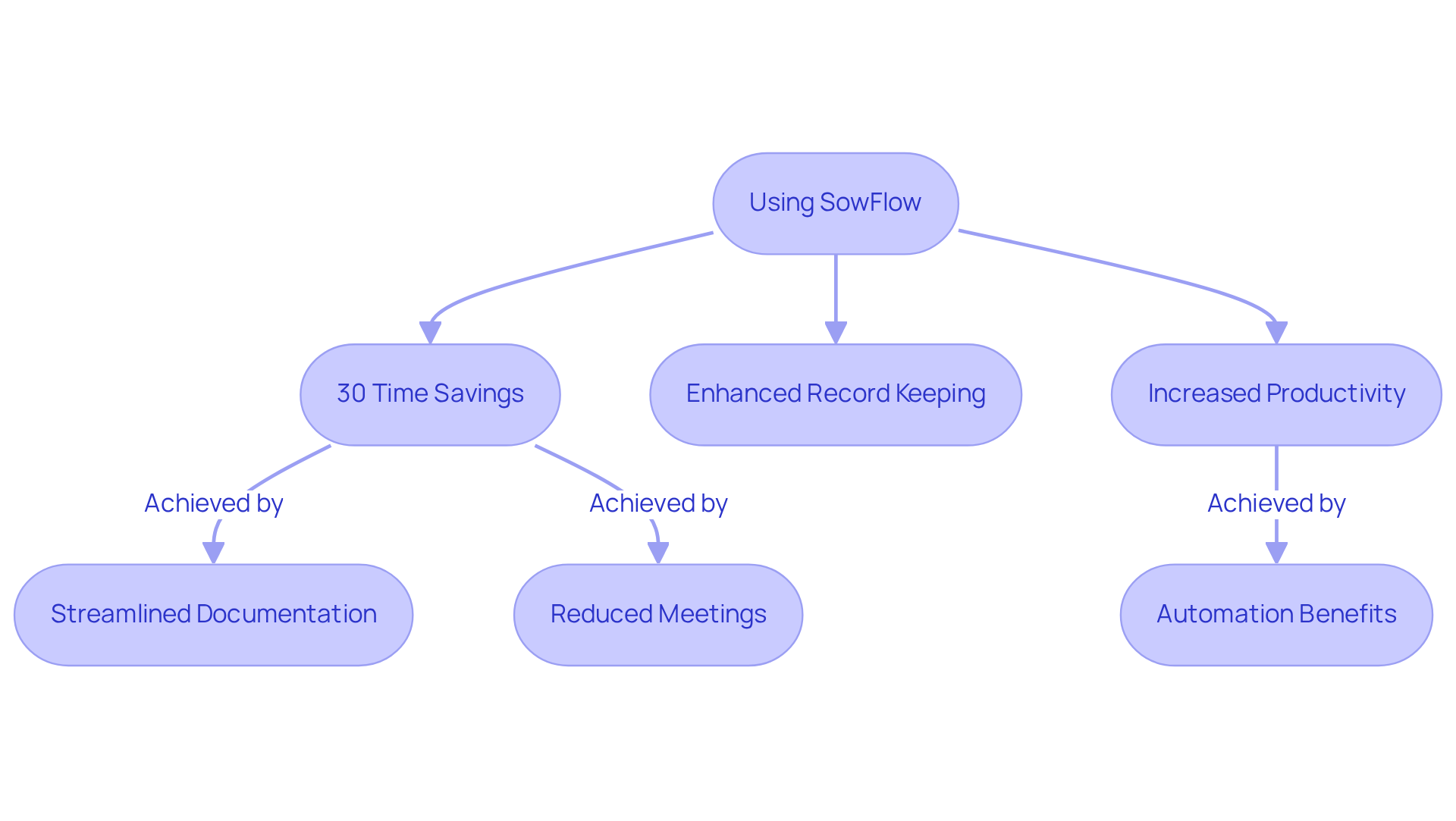
Asana: Comprehensive Process Documentation Tools
You might be wondering how to streamline your documentation process. Well, this platform has got a creative solution for you! With its free Chrome extension, you can record procedures right from your browser with just a few clicks. Imagine being able to create a procedural document example to document workflows in real-time—your team can easily store and retrieve the files they need, making procedure standardization a breeze and boosting knowledge sharing.
Now, while Asana does offer solid project management features for recording processes, this platform makes the whole recording experience much simpler. It’s like having a personal assistant that helps onboard new employees while ensuring everyone is on the same page with their roles and responsibilities. By tapping into this immediate record-keeping solution, Operations Managers can significantly ramp up team productivity.
So, why not give it a try? You’ll find that it not only enhances coordination but also makes your work life a lot easier!
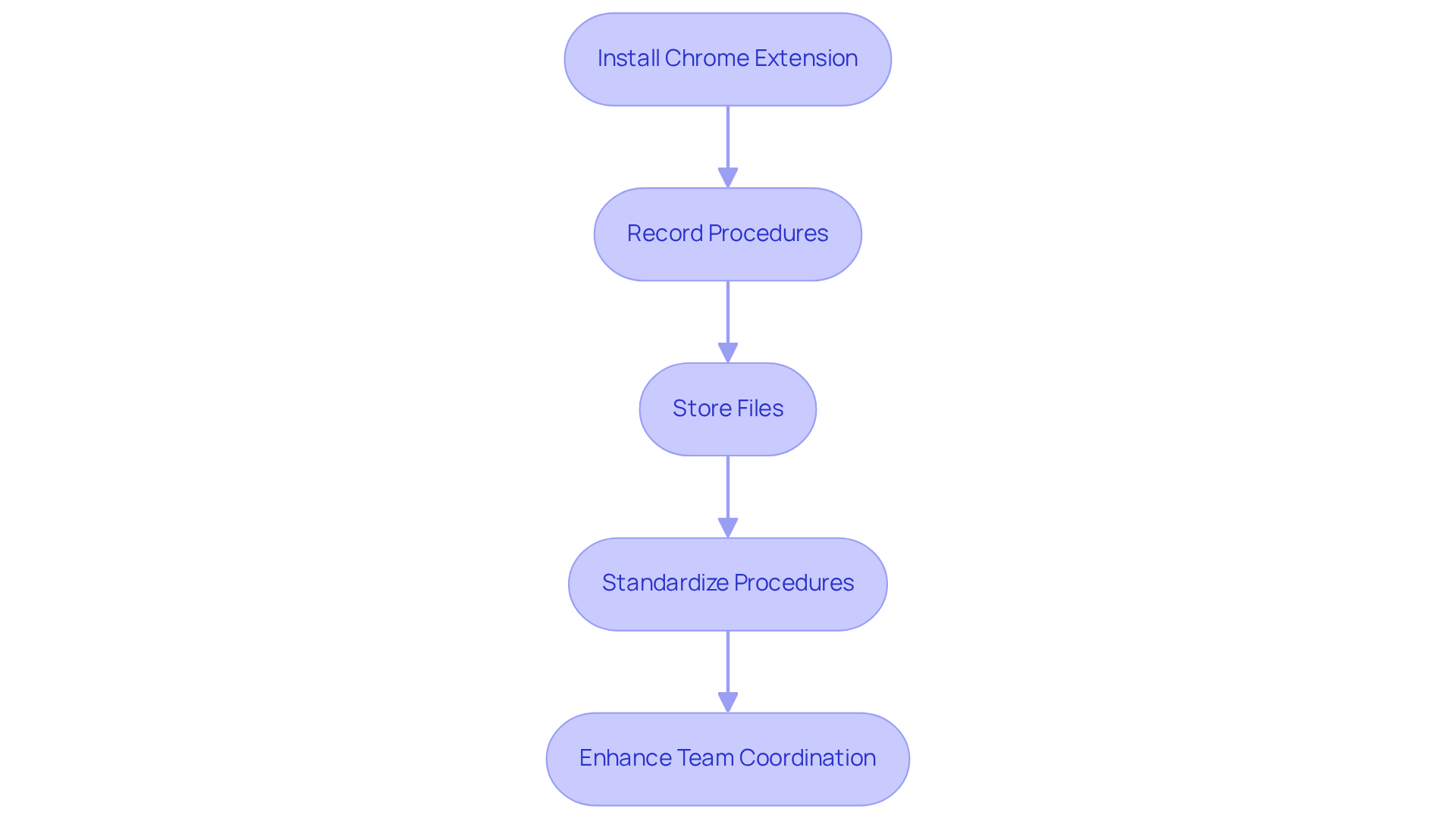
Document360: Effective Standard Operating Procedure Templates
You might be wondering how to make developing Standard Operating Procedures (SOPs) a breeze for your organization. Well, let me introduce you to SowFlow! This platform offers a groundbreaking way to tailor your records effortlessly. Imagine your teams creating user guides that cover all the essential aspects of effective record-keeping, with the ability to update them on the fly. In today’s fast-paced business world, keeping your information relevant is crucial.
Speaking of keeping things fresh, with just a single command, your teams can tap into their records and save valuable time. Plus, maintaining a uniform format across all materials is key for training and compliance. This streamlined approach not only boosts productivity but also encourages knowledge sharing and simplifies onboarding processes. If you’re an Operations Manager looking to enhance your records, a procedural document example from SowFlow could be just what you need!

Instructional Solutions: Step-by-Step Procedure Writing Guide
You might be wondering how to make your documentation really shine. A thorough procedural document example for crafting step-by-step instructions emphasizes how crucial clarity and consistency are in records. When processes are transparent, they not only help everyone understand better but also significantly cut down on mistakes, which boosts overall operational efficiency.
Organizations that prioritize well-organized records often see noticeable improvements in their workflows. Take, for instance, firms like Turkstra Lumber. They’ve managed to streamline their processes effectively, which has led to happier employees and satisfied customers.
So, what does a procedural document example of effective documentation look like? It should be user-friendly, using straightforward language and a logical structure. This way, your team can navigate tasks easily, minimizing confusion and ensuring everyone sticks to the protocols. And don’t forget—regularly reviewing and updating these documents is key. Outdated practices can lead to compliance issues and operational hiccups.
By creating a culture of clarity and consistency in your documentation, such as a procedural document example, you can really streamline operations and empower your team to tackle tasks confidently and accurately. Now, let’s dive into some practical tips to get you started!
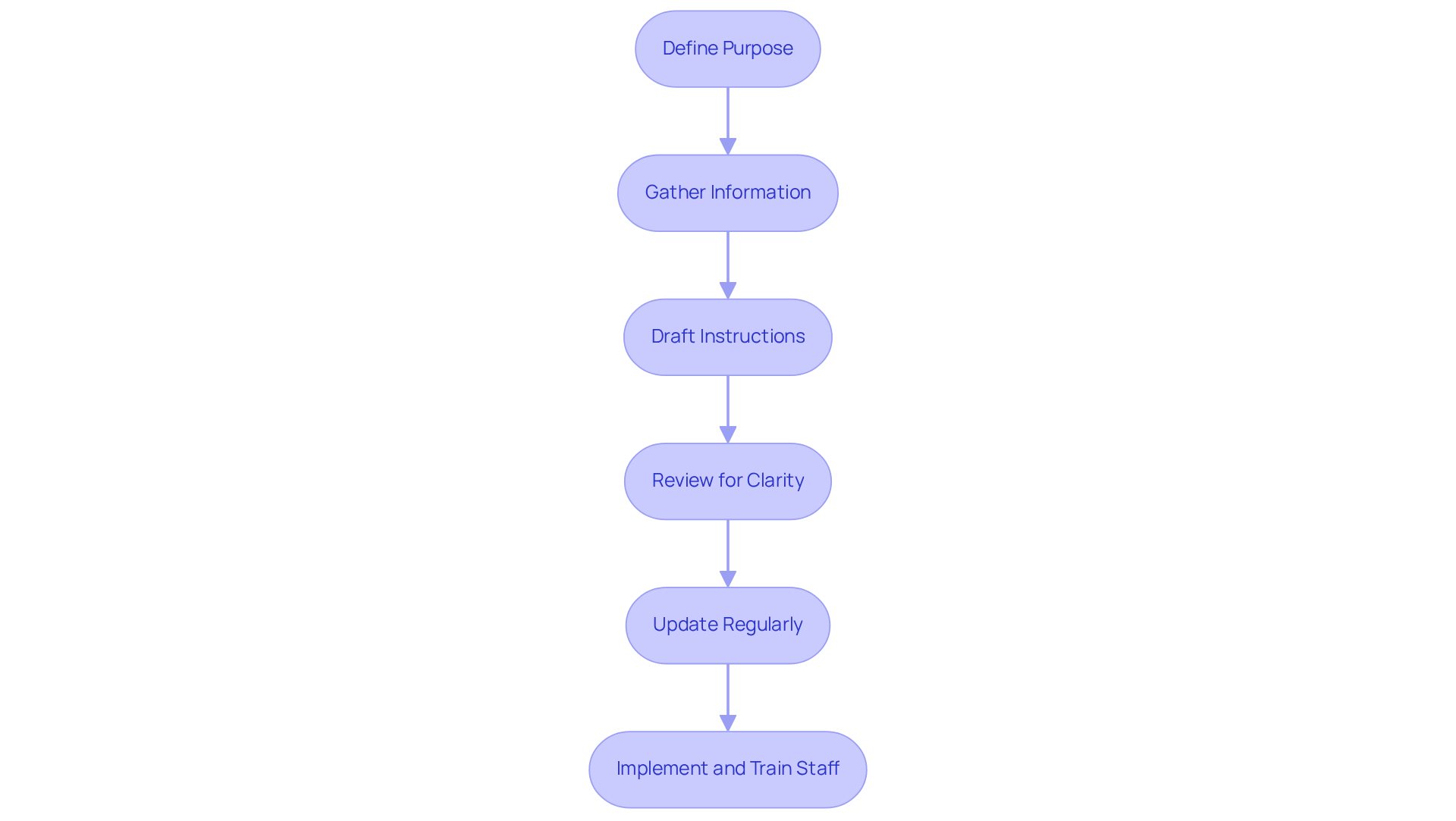
ScribeHow: Practical Examples of Business Procedures
You might be wondering how to make your business procedures more effective. Well, ScribeHow has got you covered! They showcase a procedural document example that organizations can easily adapt for their own use. These examples serve as a procedural document example to highlight different ways to document processes, whether it’s onboarding new employees or handling customer service inquiries.
By diving into these examples, you can gain valuable insights into effective recording strategies. Imagine being able to implement these strategies in your own operations! It’s all about finding what works best for you and your team. So, let’s explore how these approaches can make your documentation smoother and more efficient.

SweetProcess: Structured Procedure Writing for Consistency
You might be wondering why systematic writing is such a big deal. Well, it’s all about keeping things uniform across your documentation! With SowFlow, organizations can easily follow a clear structure when developing processes, which serves as a procedural document example that is super important for effective training and compliance. Did you know that research from Deloitte shows that companies with well-defined standard operating procedures (SOPs) can cut compliance-related risks by a whopping 60%? Plus, they can boost employee retention by up to 25%!
Now, let’s dive into how this organized approach not only makes things clearer but also makes updating and revising records a breeze as workflows shift. It keeps teams aligned and informed, which is crucial in today’s fast-paced work environment. Speaking of which, did you know that 67% of employees feel that chaotic systems hold them back? That’s according to Nintex! The solutions from SowFlow can really help ensure operational consistency and efficiency.
And here’s another interesting tidbit: normalizing procedures can actually reduce the time workers spend on administrative tasks by as much as 20%. That really highlights how important organized records are for boosting overall productivity. So, if you’re looking to streamline your processes, embracing systematic writing might just be the way to go!
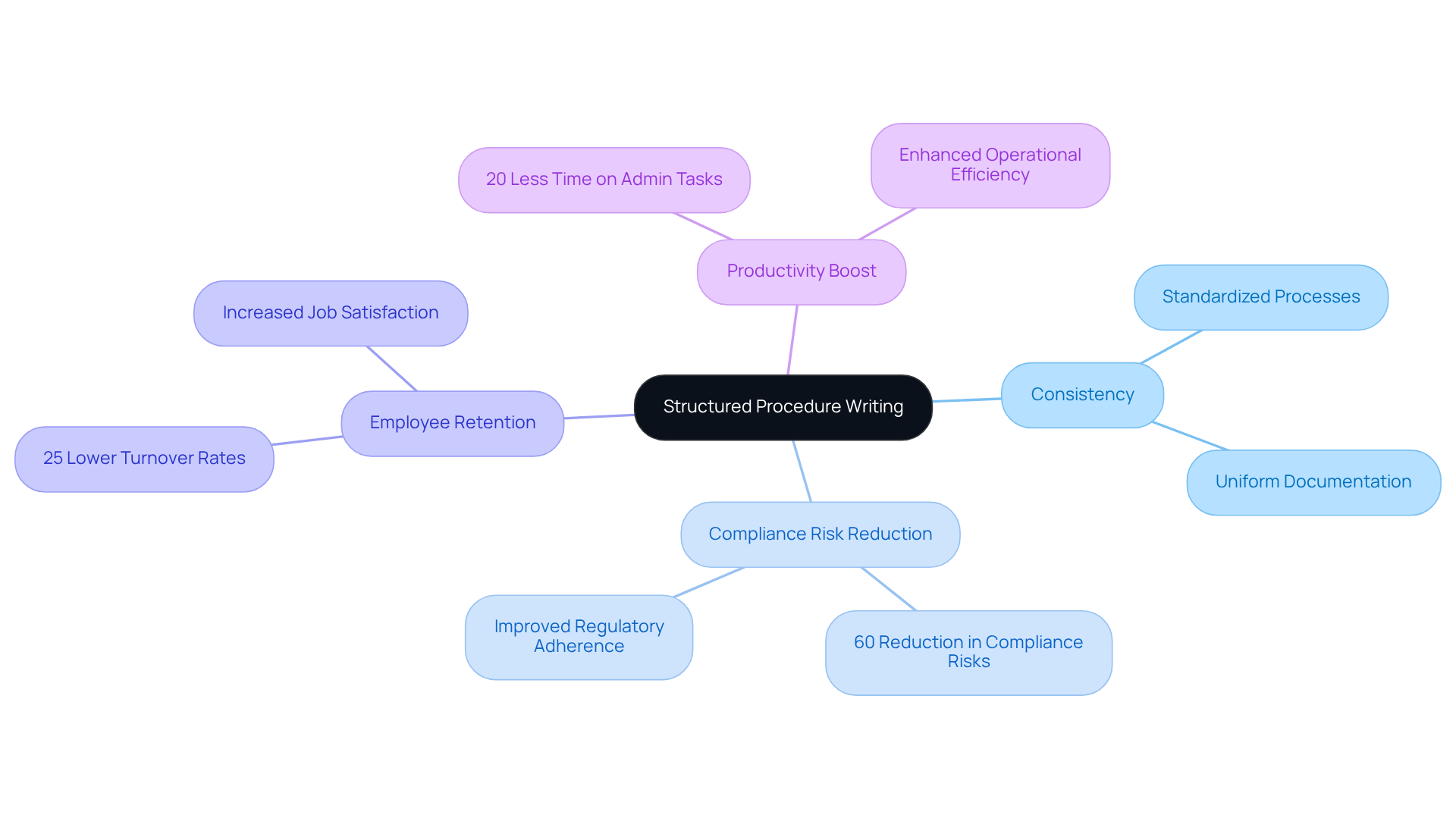
Whatfix: Enhancing Technical Documentation for Procedures
You might be wondering how to give your team immediate access to the resources they need. This platform is all about making that happen! It ensures that processes are transparent and super easy to use. With a simple creation experience, organizations can whip up user manuals and turn processes into handy how-to guides without breaking a sweat.
Now, think about those intricate processes that can be a headache. This method shines here, allowing users to tap into the knowledge of their resources with just a single command. That means fewer unnecessary meetings and a boost in overall efficiency. Pretty great, right?
Speaking of efficiency, with SowFlow, teams can easily update and revise their records. This keeps everything relevant in our fast-paced business world and really enhances productivity. So, why not explore how this platform can transform your documentation process by using a procedural document example?

Onboarding Documentation: Essential Procedures for New Hires
You might be wondering why onboarding materials are so important. Well, they play a crucial role in helping new hires get the information they need to thrive in their roles. This guide should serve as a procedural document example that includes:
- Clear training procedures
- Introductions to team members
- Access to essential resources
With a rapid record-keeping solution, organizations can easily create and update onboarding materials, making sure that new employees have the most relevant info right from day one.
Now, let’s dive into how developing comprehensive onboarding documentation with SowFlow can really streamline the transition for new employees. It helps them become productive team members faster! Best practices here include:
- Setting clear expectations
- Providing a structured first-week schedule
- Encouraging connections with peers and managers from the get-go
This approach not only cuts down the time spent on onboarding but also boosts overall employee engagement and satisfaction. In the end, it leads to a more cohesive and effective workforce. Sounds great, right?
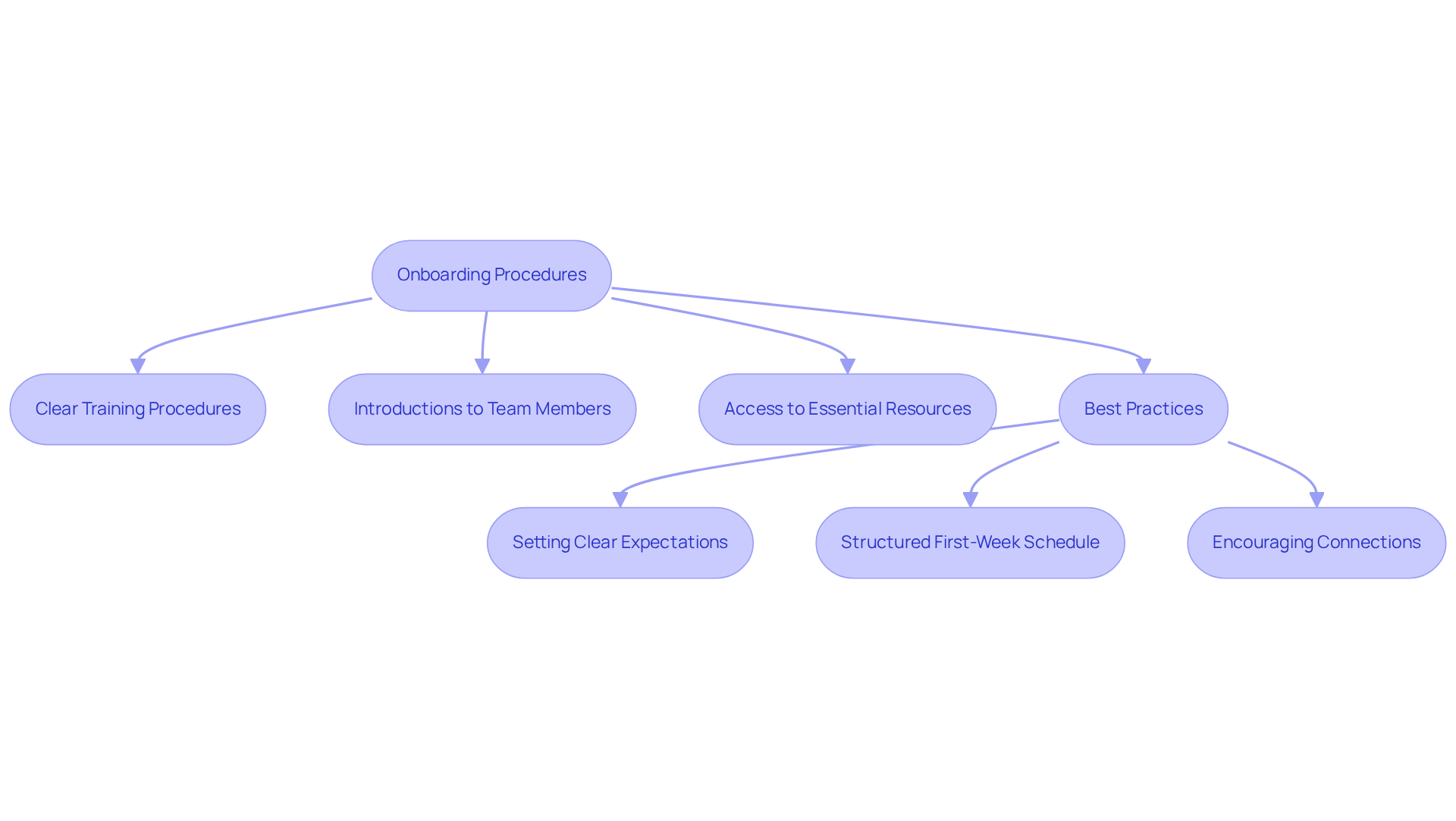
Quality Assurance Procedures: Ensuring Operational Standards
You might be wondering why quality assurance processes are such a big deal for organizations. Well, they’re absolutely crucial for keeping operational standards on point! These processes act as a procedural document example that lays out the key steps needed to maintain quality in products and services, allowing companies to spot and fix issues before they snowball into bigger problems. When you implement solid quality assurance measures, you’re not just ticking boxes; you’re boosting operational efficiency and customer satisfaction.
For example, have you heard that companies embracing effective quality management practices can see an average sales increase of 9%? And get this—a whopping 26% jump in profitability! That’s not just pocket change. Plus, the Cost of Poor Quality (COPQ) can eat up anywhere from 5% to 30% of sales revenue, which really drives home the financial impact of not having good quality control in place.
By establishing a procedural document example for standardized quality assurance procedures, organizations can streamline their operations and foster a culture of continuous improvement. This leads to better customer experiences and fewer defects. Speaking of success, many companies using statistical control (SPC) techniques have found they can effectively monitor their capabilities. This proactive approach helps them dodge defects and stay in line with customer specifications. So, this commitment to quality doesn’t just make operations smoother; it also helps businesses shine as leaders in their industries.

Process Mapping: Visualizing Workflows for Better Documentation
You might be wondering how workflow mapping can really make a difference in your organization. Well, it’s a powerful tool that helps create visual representations of workflows, significantly improving the creation of a procedural document example for processes. By carefully mapping out each step, organizations can easily spot bottlenecks, clarify who’s responsible for what, and streamline their operations. This visual approach not only makes complex procedures easier to understand but also serves as a vital guide for training and compliance, ensuring that everyone on the team knows their roles and responsibilities.
Research shows that visualizing workflows can lead to some impressive boosts in operational efficiency. For instance, organizations that embrace effective business workflow mapping often find that their operations become clearer, which can lighten employee workloads and enhance morale. However, it’s important to keep in mind that BPM can stumble for a variety of reasons, such as poor documentation or the absence of a procedural document example during the implementation of methodologies. Tackling these issues is key to successful BPM initiatives.
Did you know that the global business workflow management market was valued at $10.64 billion in 2020 and is expected to reach $26.18 billion by 2028? This growth highlights how crucial organized workflow management has become. A well-crafted business workflow map offers a clear view of development needs and sequencing, ultimately leading to happier customers. By lining up activities in a sequential order to create a value chain—covering sales, implementation, support, marketing, and operations—companies can manage their tasks and sub-tasks more effectively. This structured method, which includes grasping the process hierarchy, not only boosts operational clarity but also nurtures a culture of continuous improvement, making it easier for organizations to adapt to changing business landscapes. Plus, keeping everyone in the loop to regularly monitor progress is vital for the success of BPM initiatives.
So, what challenges are you facing with your procedural document example? Let’s dive into how you can tackle them!
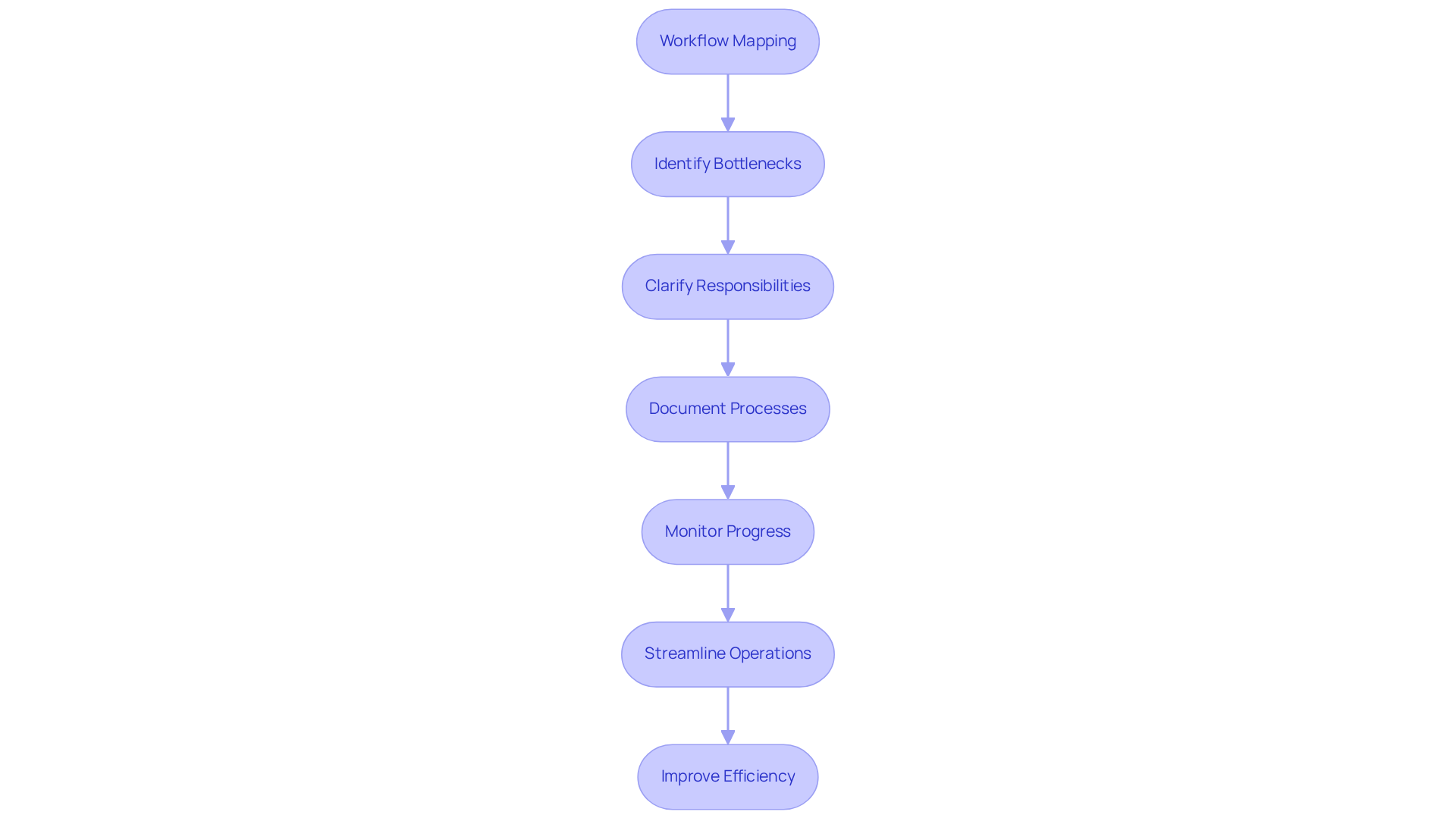
Conclusion
Streamlining operations through effective procedural documentation isn’t just a passing trend; it’s a must for organizations looking to boost efficiency and productivity. You might be wondering how to get started, right? Well, this article dives into some great platforms and techniques like SowFlow, Asana, and Document360, which offer valuable examples of procedural documents to make creating and managing Standard Operating Procedures (SOPs) a breeze. By adopting these tools, businesses can cut down on the time spent on documentation, improve knowledge sharing, and nurture a culture of clarity.
Now, let’s talk about why structured documentation is so crucial. It ensures compliance, enhances onboarding processes, and keeps quality assurance in check. Each platform mentioned has its own unique features tailored to meet specific operational needs, whether it’s crafting user-friendly guides, mapping workflows, or making onboarding for new employees a smooth ride. And the perks of having well-organized procedural documents go beyond just efficiency; they can actually boost employee satisfaction and enhance customer experiences too.
So, in conclusion, embracing effective procedural documentation is vital for any organization that wants to thrive in today’s fast-paced business world. By leveraging the right tools and techniques, companies can streamline their operations and empower their teams to work more confidently and collaboratively. The time to act is now—why not explore these procedural document examples and transform your organization’s approach to documentation for a more efficient and productive future?
Frequently Asked Questions
What is SowFlow and how does it benefit organizations?
SowFlow is a platform that allows teams to create Standard Operating Procedures (SOPs) quickly and efficiently. It features a user-friendly Chrome extension that enables users to document workflows directly from their browser, leading to reported time savings of up to 30%.
How does SowFlow improve operational efficiency?
By streamlining the documentation process, SowFlow enhances operational organization and boosts overall efficiency. It helps maintain updated records, standardizes processes, and reduces the need for repetitive meetings, thereby increasing productivity.
What percentage of knowledge workers believe automation increases productivity?
According to the article, 66% of knowledge workers say that automation leads to increased productivity.
What features does Asana offer for process documentation?
Asana provides a free Chrome extension that allows users to record procedures in real-time with just a few clicks. This facilitates easy storage and retrieval of files, making procedure standardization and knowledge sharing simpler.
How does Asana assist in onboarding new employees?
Asana acts like a personal assistant by helping to onboard new employees and ensuring that everyone understands their roles and responsibilities, which enhances team productivity.
What does Document360 offer for developing SOPs?
Document360 offers effective templates for creating Standard Operating Procedures (SOPs) that can be easily tailored and updated. This helps maintain relevant information and ensures a uniform format for training and compliance.
Why is maintaining a uniform format important in SOPs?
A uniform format is crucial for training and compliance as it ensures consistency across all materials, which simplifies onboarding processes and encourages knowledge sharing.
👍
What others are liking
5 Steps to outline your ideal documentation structure
5 MINS READ
Where to start the your journey of mapping out your ideal documentation structure, aligning it with the very heartbeat of your organization?
Defining a winning level of detail in your process
3 MINS READ
What is too much detail, and what is too little? This article described in that winning level detail about what detail is enough.





